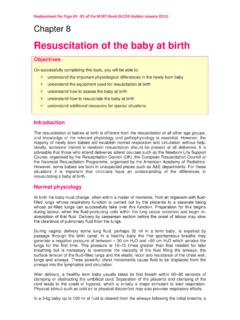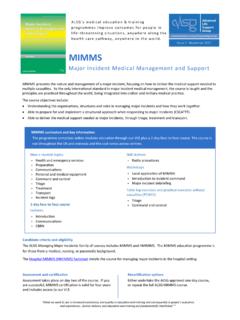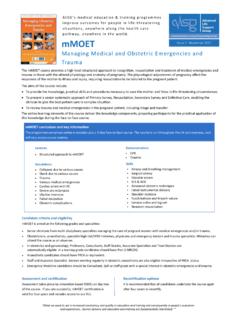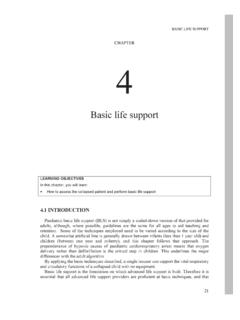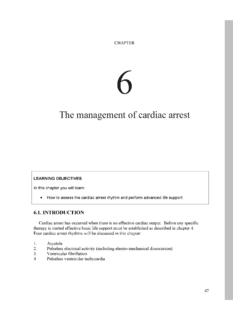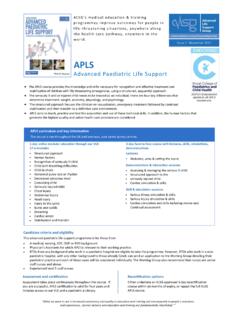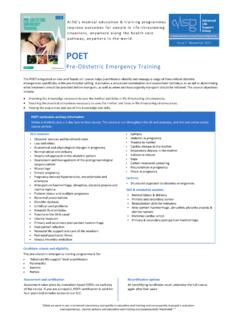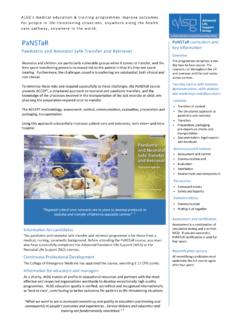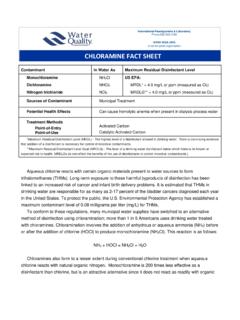Transcription of Resuscitation of the baby at birth - ALSG Home
1 Replacement for Page 69 - 81 of the MOET Book (ILCOR Update January 2011). Chapter 8. Resuscitation of the baby at birth Objectives On successfully completing this topic, you will be able to: understand the important physiological differences in the newly born baby understand the equipment used for Resuscitation at birth understand how to assess the baby at birth understand how to resuscitate the baby at birth understand additional measures for special situations Introduction The Resuscitation of babies at birth is different from the Resuscitation of all other age groups, and knowledge of the relevant physiology and pathophysiology is essential. However, the majority of newly born babies will establish normal respiration and circulation without help. Ideally, someone trained in newborn Resuscitation should be present at all deliveries.
2 It is advisable that those who attend deliveries attend courses such as the Newborn Life Support Course, organised by the Resuscitation Council (UK), the European Resuscitation Council or the Neonatal Resuscitation Programme, organised by the American Academy of Pediatrics. However, some babies are born in unexpected places such as A&E departments. For these situations it is important that clinicians have an understanding of the differences in resuscitating a baby at birth . Normal physiology at birth the baby must change, often within a matter of moments, from an organism with uid- lled lungs whose respiratory function is carried out by the placenta to a separate being whose air- lled lungs can successfully take over this function. Preparation for this begins during labour, when the uid-producing cells within the lung cease secretion and begin re- absorption of that uid.
3 Delivery by caesarean section before the onset of labour may slow the clearance of pulmonary uid from the lungs. During vaginal delivery some lung fluid, perhaps 35 ml in a term baby , is expelled by passage through the birth canal. In a healthy baby the first spontaneous breaths may generate a negative pressure of between 30 cm H2O and 90 cm H2O which aerates the lungs for the first time. This pressure is 10 15 times greater than that needed for later breathing but is necessary to overcome the viscosity of the fluid filling the airways, the surface tension of the fluid-filled lungs and the elastic recoil and resistance of the chest wall, lungs and airways. These powerful chest movements cause fluid to be displaced from the airways into the lymphatics and circulation. After delivery, a healthy term baby usually takes its first breath within 60 90 seconds of clamping or obstructing the umbilical cord.
4 Separation of the placenta and clamping of the cord leads to the onset of hypoxia, which is initially a major stimulant to start respiration. Physical stimuli such as cold air or physical discomfort may also provoke respiratory efforts. In a 3-kg baby up to 100 ml of fluid is cleared from the airways following the initial breaths, a Replacement for Page 69 - 81 of the MOET Book (ILCOR Update January 2011). process aided by full inflation and prolonged high pressure on expiration, crying. The effect of the first few breaths is to produce the baby s functional residual capacity. Neonatal circulatory adaptation commences with the detachment of the placenta, but lung inflation and alveolar distension releases mediators, which affect the pulmonary vasculature as well as increase oxygenation. Pathophysiology Our knowledge of the pathophysiology of fetal asphyxia is based on pioneering animal work in the early 1960s.
5 The results of these experiments, which followed the physiology of newborn animals during acute, total, prolonged asphyxia and subsequent Resuscitation are summarised in Figure When the placental oxygen supply is interrupted, the fetus attempts to breathe. Should these attempts fail to provide an alternative oxygen supply as they will inevitably fail to do so in utero the baby will lose consciousness. If hypoxia continues, the respiratory centre becomes unable, through lack of sufficient oxygen, to continue initiating breathing and the breathing stops, usually within 2 3 minutes (primary apnoea, Figure ). Resps Primary Terminal Northern Neonatal Network apnoea apnoea Pa O2. Pa CO2. id ss ac Lung Exce Inflation IPPV. 160. Heart 120 rate CC. 80. 40. BP. 0. 0 10 20 30 40 minutes Figure Response of a mammalian fetus to total, sustained asphyxia started at time 0.
6 Fetal bradycardia ensues but blood pressure is maintained, primarily by peripheral vasocon- striction and diversion of blood away from non-vital organs, and also by an increased stroke volume. After a latent period of apnoea (primary), primitive spinal centres, no longer suppressed by neural signals from the respiratory centre, exert an effect by initiating primitive gasping breaths. These deep spontaneous gasps are easily distinguishable from normal breaths as they only occur 6 12 times per minute and involve all accessory muscles in a maximal inspiratory effort. After a while, if hypoxia continues, even this activity ceases (terminal apnoea). The time taken for such activity to cease is longer in the newly born baby than in later life, taking up to 20 minutes. The circulation is almost always maintained until all respiratory activity ceases.
7 This resilience is a feature of all newborn mammals at term, largely due to the reserves of glycogen in the heart. Resuscitation is therefore relatively easy if undertaken before all Replacement for Page 69 - 81 of the MOET Book (ILCOR Update January 2011). respiratory activity has stopped. Once the lungs are in ated, oxygen will be carried to the heart and then to the brain provided the circulation is still functional (Figure ). Recovery will then be rapid. Most infants who have not progressed to terminal apnoea will resuscitate themselves if their airway is patent. Once gasping ceases, however, the circulation starts to fail and these infants are likely to need more extensive Resuscitation (Figure ). Resps Primary Terminal Northern Neonatal Network apnoea apnoea Pa O2. Pa CO2 i d ss ac Lung Exce Inflation 160.
8 Heart 120 rate 80. 40. BP. 0. 0 10 20 30 40 minutes Figure Effects of lung inflation and a brief period of ventilation on a baby born in early terminal apnoea but before failure of the circulation (Reproduced with permission from the Northern Neonatal Network). Resps Primary Terminal Northern Neonatal Network apnoea apnoea Pa O2. Pa CO2. i d ss ac Lung Exce Inflation IPPV. 160. Heart 120 rate CC. 80. 40. BP. 0. 0 10 20 30 40 minutes Figure Response of babies born in terminal apnoea. In this case lung inflation is not sufficient because the circulation is already failing. However, lung inflation delivers air to the lungs and then a brief period of chest compressions (CC) delivers oxygenated blood to the heart which then responds.(reproduced with permission from the Northern Neonatal Network). Replacement for Page 69 - 81 of the MOET Book (ILCOR Update January 2011).
9 Equipment For many newborn babies, especially those born outside the delivery room, the need for Resuscitation cannot be predicted. It is therefore useful to plan for such an eventuality. Equipment, which may be required to resuscitate a newborn baby is listed in Table This will vary between departments; however, most babies can be resuscitated with a at surface, warmth, knowledge and a way to deliver air or oxygen at a controlled pressure. Table Equipment for newborn Resuscitation A flat surface Radiant heat source and dry towels (or suitable plastic bags for preterm infants). Suction with catheters at least 12 Fr Face masks Bag-valve-mask or T piece w pressure limiting device Source of air and/or oxygen Oropharyngeal (Guedel) airways Laryngoscopes with straight blades, 0 and 1. Nasogastric tubes Cord clamp Scissors Tracheal tubes sizes to mm Umbilical catheterization equipment Adhesive tape Disposable gloves Plastic bag for preterm babies Saturation monitor/stethoscope Strategy for assessing and resuscitating a baby at birth Resuscitation is likely to be rapidly successful if begun before the baby has become so anoxic that all potential for respiratory activity has vanished.
10 Babies in primary apnoea can usually resuscitate themselves if they have a clear airway. As you do not know whether a newborn, apnoeic baby is in primary or secondary apnoea you must develop a graded approach that will work in either situation. Always start by drying and covering the baby to prevent it from getting cold and then proceed as far as it is necessary down the following list: Call for help Start the clock or note the time Dry, and cover the baby Assess the situation Airway Breathing Chest Compressions (Drugs). Replacement for Page 69 - 81 of the MOET Book (ILCOR Update January 2011). Call for help Ask for help if you expect or encounter any difficulty or if the delivery is outside the labour suite Start clock If available, or note the time of birth at birth There is no need to rush to clamp the cord, particularly if the baby appears well.
